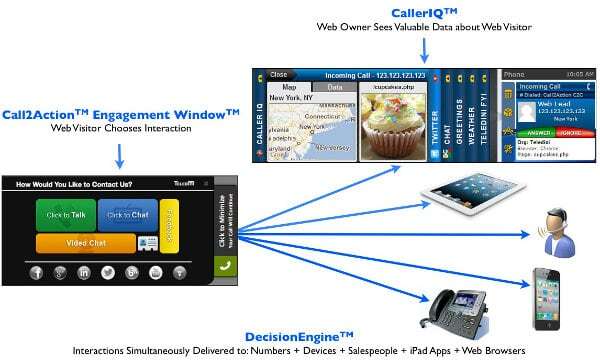Converting visitors to traffic by maintaining the engagement onsite.
WebRTC brings with it the ability to “close the loop” – have a person search you or your service on Google, check your website and then reach out – all within the comforts of a web browser.
Teledini is a company that enables just that.
 I knew of Teledini for some time now, and saw their platform during the WebRTC Expo & Conference in Atlanta. Here’s an interview with Teledini’s President & COO, Steve Smithwick.
I knew of Teledini for some time now, and saw their platform during the WebRTC Expo & Conference in Atlanta. Here’s an interview with Teledini’s President & COO, Steve Smithwick.
What is Teledini all about?
Problem: Despite investing countless hours and dollars on content, design, pay-per-click advertising, and search engine optimization, businesses take an average of 42 hours to interact with a visitor to their site. As a result, the conversion rate of website visitors into customers for most businesses is unacceptably low (1-4%).
Solution: Teledini enables instant interaction between the website visitor and the site owner, while simultaneously delivering valuable data about the visitor to the owner, improving conversion rates by as much as 60%.
Products/Services: Teledini’s instant interaction tools can be placed on any website in less than 20 minutes. Teledini is completely free to set up and easy to install. Website owners simply copy and paste a few lines of code into the footer of their website. They don’t pay until they are connected to a purchase-ready customer. Teledini’s solution is comprised of three integrated components:
- Call2Action™ EngagementWindow™ – Website owners can place a unique Call2Action button on each page of their website. When a visitor clicks the Call2Action button, a sleek EngagementWindow slides out. Web visitors are offered a myriad of ways to connect with the business and can choose the interaction method they are most comfortable using. The choices include: Click-to-Talk, Click-to-CallMeBack, Click-to-Chat, Click-to-Video and Click-to-Message. Contact numbers and location information for the business are also delivered in the EngagementWindow. Teledini’s Call2Action EngagementWindow replaces the traditional “contact us” page on a website that is both antiquated and proven ineffective.
- DecisionEngine™ – Teledini features sophisticated interaction routing. Each interaction is delivered to the right person at the right time. Web owners can choose to simultaneously ring multiple numbers, people and devices based on product or page. Salespeople have the flexibility to determine how and when they can be reached most effectively by choosing their numbers, devices and availability.
- CallerIQ™ – CallerIQ helps to maximize the value of customer interactions by displaying key information about a web visitor at the instant the interaction is delivered to the right person. This enables immediate relevant responses to the web visitor and opens up tremendous tracking capabilities. CallerIQ reports make it possible to track online campaigns, banner advertising and site performance on a page-by-page basis not only periodically, but in real time as desired.

What excites you about working in WebRTC?
WebRTC expands your ability to communicate.
WebRTC puts voice, video and peer-to-peer connectivity right in to the backbone of the browser. To many, this may not sound like a disruptive event for the Internet, but this is not just another browser update. Now any web developer can add live communication to a web app. And the services they’ll create will be available to any device with a browser, free of installations, plug-ins, and stand-alone applications. Suddenly, the number of developers capable of utilizing this sort of technology becomes huge. And all of those new imaginings will foster the creation of products and services that we can’t even fathom yet. New business models will emerge and the way people interact with the Web and everything on it will change.
WebRTC has huge business implications.
Think of the implications for business. We’re all aware of how little time it takes for once-astonishing technologies to become affordable and then cheap. The same trend is true for businesses seeking to utilize communication technology, and in this case largely thanks to advancements like WebRTC. Now, virtually anyone can compete in the communication world; it no longer takes millions of dollars to imagine a browser-based Skype alternative. One could certainly envision customer service and sales teams finding innovative and interesting uses for multimedia collaboration and communication with their online audiences.
What do you offer on top of basic WebRTC connectivity via the browser?
- Click-to-Talk uses WebRTC in Chrome and Firefox. In browsers that don’t support WebRTC we gracefully degrade to Flash Player
- Click-to-CallMeBack uses SIP to SIP
- Click-to-Video uses WebRTC in Chrome and Firefox. To date, we don’t support Video in other browsers
- Click-to-Chat uses XMPP
Can you tell me more about your widget framework?
The first layer of the Teledini solution, the EngagementWindowTM (the consumer-facing front-end), uses a cross-browser compatible interface to entice the customer to initiate a communication session. This technology is hosted on our CDN, but allows CSS and JS include overrides for custom look & feel as well as behaviors. A custom code snippet is required for the web owner’s site and is immediately available to the web owner at sign up.
The second layer is the “widget framework”, our web owner’s interface. CallerIQTM is our flagship widget in the framework. The widget framework is available as a Firefox add-on. In this layer we use accessible data available (IP and/or caller ID) for both internal and external partner web service calls to retrieve intelligence about the call. While viewing this intelligence the web owner’s agent can also answer the call directly from the widget framework. We make available an SDK for developers to create custom widgets, which are written in a combination of HTML, CSS and JavaScript. The widget framework serves as an agent dashboard that is free to install, simple to learn and configure and is powerful enough to be infinitely extensible with custom widgets.
The final layer, DecisionEngineTM uses Teledini’s development platform for business process management, call routing and voicemail. The platform is an agile, rapid-development platform focused on multi-media communications. A call-routing template drives the device ring plan using the selections made within the Teledini portal. Furthermore, the platform is extensible enough to drive enterprise-grade, sophisticated workflow processes.
Where do you see WebRTC going in 2-5 years?
WebRTC outlook: We anticipate rapid adoption of WebRTC across all devices. We see a flood of new applications in 2014 that leverage the power of voice and video embedded natively in the browser.
Teledini outlook: Teledini is at the forefront of WebRTC adoption with innovative products that deliver real solutions to the nagging problem for business owners of converting web visitors into customers. We believe that most websites will offer instant interaction tools to their web visitors in the next 3-5 years. Teledini plans to be the market leader, driving this adoption by delivering a more productive and satisfying web experience for our clients and their customers.
If you had one piece of advice for those thinking of adopting WebRTC, what would it be?
“Professional driver on a closed course. Do not try this at home.” 😉 On a serious note, for those who are hesitant to adopt WebRTC today, know that it will continue to mature and as the standard becomes finalized, its promise of ubiquitous communication will be fulfilled.
Given the opportunity, what would you change in WebRTC?
We would like to see a final adoptable standard as soon as possible. (We also want to see Safari and Internet Explorer embrace WebRTC!)
What’s next for Teledini?
Launching from Atlanta-based incubator StarPound, Teledini represents a commercial application of the long-held vision for a more collaborative Web. Teledini is currently in a controlled beta.
In Q4 2013, Teledini plans its spin out as a standalone company to coincide with general availability and a Series A financing.
Teledini plans to be the market leader in customer engagement solutions, driving adoption by delivering a more productive and satisfying web experience for our clients and their customers.
–
The interviews are intended to give different viewpoints than my own – you can read more WebRTC interviews.

I can see the entire browser landscape changing over the next 12-24 months. Business applications like live video may force a new operating structure in large customer service departments.
Can you imagine what you might see today if the on line service group had to share a live video stream?